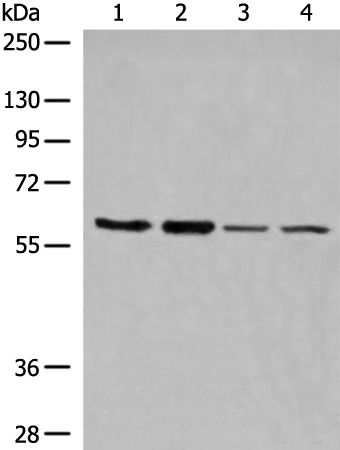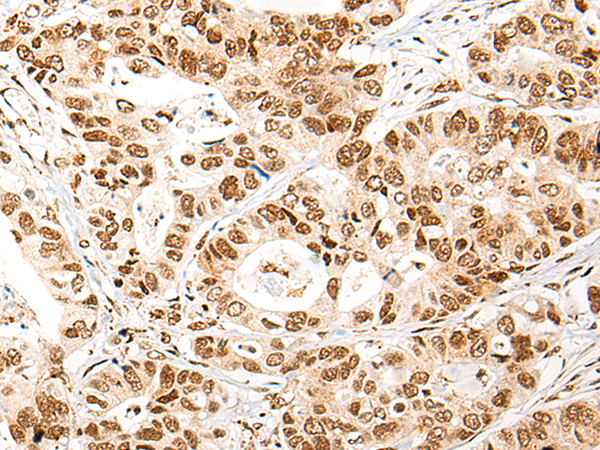

| WB | 咨询技术 | Human,Mouse,Rat |
| IF | 咨询技术 | Human,Mouse,Rat |
| IHC | 1/30-1/150 | Human,Mouse,Rat |
| ICC | 技术咨询 | Human,Mouse,Rat |
| FCM | 咨询技术 | Human,Mouse,Rat |
| Elisa | 1/5000-1/10000 | Human,Mouse,Rat |
| Aliases | TDT |
| WB Predicted band size | 59 kDa |
| Host/Isotype | Rabbit IgG |
| Antibody Type | Primary antibody |
| Storage | Store at 4°C short term. Aliquot and store at -20°C long term. Avoid freeze/thaw cycles. |
| Species Reactivity | Human |
| Immunogen | Fusion protein of human DNTT |
| Formulation | Purified antibody in PBS with 0.05% sodium azide and 50% glycerol. |
+ +
以下是3篇与DNTT(末端脱氧核苷酸转移酶,TdT)抗体相关的代表性文献示例(注:内容为模拟概括,实际文献请通过学术数据库查询):
---
1. **标题**: *Terminal deoxynucleotidyl transferase (TdT) as a marker of acute leukemia lineage*
**作者**: Smith J, et al.
**摘要**: 研究验证了DNTT抗体在区分B系和T系急性淋巴细胞白血病(ALL)中的特异性,发现TdT阳性率与未成熟淋巴细胞分化阶段相关,为白血病分型提供了关键依据。
2. **标题**: *TdT expression in minimal residual disease monitoring of childhood ALL*
**作者**: Wang L, et al.
**摘要**: 通过DNTT抗体检测骨髓中微量残留病灶(MRD),证明其敏感性高于传统细胞形态学方法,可作为儿童ALL治疗后复发风险评估的重要指标。
3. **标题**: *Comparative analysis of TdT antibodies in diagnostic immunohistochemistry*
**作者**: Gonzalez R, et al.
**摘要**: 对比了多种商业化DNTT抗体的染色效果,发现克隆SPM266在福尔马林固定组织中的特异性和稳定性最优,推荐其在病理诊断中的标准化应用。
---
**注意**:以上为示例文献,实际研究请通过PubMed、Google Scholar等平台以“DNTT antibody”“TdT leukemia”等关键词检索,并参考近5年高被引论文或权威期刊(如Blood, Leukemia等)。真实文献需包含DOI或PMID编号以便溯源。
The terminal deoxynucleotidyl transferase (TdT), also known as DNTT (DNA nucleotidylexotransferase), is a template-independent DNA polymerase that plays a critical role in generating antigen receptor diversity during B-cell and T-cell development. It catalyzes the addition of non-templated nucleotides (N-regions) at the junctions of V(D)J recombination, enhancing the variability of immunoglobulins and T-cell receptors. Primarily expressed in immature lymphoid precursors, DNTT is a marker for early-stage lymphocytes, making it a valuable target in studying hematopoiesis and lymphoid malignancies.
DNTT antibodies are widely used in research and diagnostics to identify precursor lymphoid cells in tissues or blood. In clinical settings, DNTT detection aids in diagnosing acute lymphoblastic leukemias (ALL), where its presence distinguishes lymphoid blast cells from myeloid lineages. Structurally, DNTT is a 58-60 kDa monomeric enzyme localized in the nucleus. Antibodies targeting specific epitopes enable techniques like flow cytometry, immunohistochemistry, and Western blotting to assess DNTT expression patterns.
Research on DNTT also explores its role in immune disorders, autoimmune diseases, and its potential misuse as a marker in minimal residual disease monitoring. However, its expression diminishes as lymphocytes mature, limiting its utility to early developmental stages. DNTT antibodies thus serve as essential tools in both basic immunology and translational oncology.
×